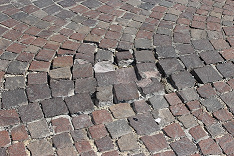 The external paving in porphyry, according to good rule of the art does not require a maintenance very costly and has a good durability, in virtue of the excellent physical-mechanical characteristics of the porphyry and the materials used to seal the joints between the various elements.
The external paving in porphyry, according to good rule of the art does not require a maintenance very costly and has a good durability, in virtue of the excellent physical-mechanical characteristics of the porphyry and the materials used to seal the joints between the various elements.
Moreover, the versatility of this type of floor allows him to have a varied availability of laying patterns, able to satisfy any requirement.
Possible defects of the floor in porphyry
floor defects in porphyry (photo Ing Guild Montesano) Often, however this flooring with time can manifest defects that are visible to the naked eye, as the crumbling of the joints between the individual cubes, which sometimes involves lifting of the same or the formation of depressions on the surface, that it is no longer planar will skew all gradients, resulting in other problems relating to the outflow of rainwater.
What to look? The phases of the laying of the porphyry
The laying of the cubes and the proper implementation of the various layers are key factors that ensure the quality and durability of the flooring that you are going to achieve.
It can be simply divided into four phases:
1 – The formation of the substrate, which is one of the cornerstones of installation. The substrate is the most resistant on which then must rest the flooring, and on which they’re going to download all the concentrated loads and not, for which must remain unchanged in time preserving its physical-mechanical characteristics.
Before the substrate was achieved using ballast made of blocks of stone were used lands or mixed dry and then were going to form a layer which then had to be leveled in order to give a proper slope for drainage of rainwater.
Today, however, the substrate is performed by providing a concrete slab consists of
a mixture of sand, gravel, water and cement with standard dose about 2 q.li per cubic meter.
This will have a thickness of 10 cm / 15 with embedded mesh sheets of 6 mm x 20/20.
background pavimentazioneIl substrate thus produced is always advisable as highly suitable for the realization of all the floors in natural stone. 1,5 %), con la predisposizione di adeguati punti di raccolta e smaltimento”>Obviously it is important to avoid creating problems to the pavement then predict the correct slope of the surface water with a minimum slope of 1.5 cm per linear meter (> 1.5%), with the establishment of appropriate collection points and disposal of water.
Importantly, the execution of a substrate not to rule of art is almost always the main cause of localized fracturing that inevitably will report on the finished flooring.
To avoid the occurrence of this problem should be avoided as much as possible subsequent shots in the jet, as well as adhere to the period of stagionamento and settling of the same, 30 days before proceeding to the implementation of the pavement.
2 – The lure; talking about external paving the best system is the one that involves the use of crushed coarse sand of diameter ranging from 0-6 mm, clean and free of ferrous parts. The sand used for the bedding layer will be mixed with cement to dry to avoid that there are cali.battitura floor porphyry
3 – Cleaning and typing are performed after laying. With the help of special brushes, you will have to clean the surface of the pavement and all the spaces left between one element and the other filled with a mixture of sand and cement.
Subsequently with the aid of hammers will have to compress the individual pieces in the state of entrapment up to their final location. The typing is performed in at least two stages that must be carried out along two mutually orthogonal directions. Before performing the beating you will have to throw the entire surface of a layer of water so as to make the bedding layer and more walkable and facilitating the final settling of the floor.
sealing giunti4-sealing is the last stage of the work, this is performed by spreading on the pavement, after the beating, a layer of fine sand of the diameter which can vary from 0-4 mm, trying to fill all the interstices through the use of special brushes. Then we proceed with the drafting of the slurry obtained by mixing fine sand, water and cement. This mixture once lying on the floor will have to escape each compacted present between the individual elements of porphyry, and to make sure that this operation be conducted according to the rules of art there makes use of rubber brushes. When you realize that is beginning phase will be taken by the operator to begin the process of clearing the pavement with a jet of water to remove the excess grout.
